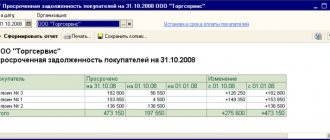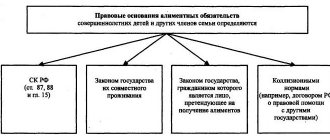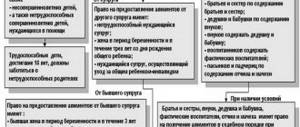Where can I get advice and services for collecting accounts receivable? What does a sample collection letter look like? When does foreclosure on receivables not occur?
Welcome to the popular online magazine “HeaterBeaver”! Expert in touch - Denis Kuderin.
The topic of the new publication is “Collection of accounts receivable.” The material will be useful to both beginners and experienced entrepreneurs, as well as anyone interested in the financial security of a business.
Read carefully: at the end of the article, an overview of the most competent companies in the Russian Federation involved in the collection of receivables will be given, and situations where it is impossible to repay such debts will be considered.
What is accounts receivable collection?
Before studying the process of collecting receivables, you should first understand the terminology.
Almost every business enterprise has accounts receivable. A debtor is a debtor who has not paid for supplies and services within the time limits specified in contracts and agreements.
Accounts receivable is the amount of debts not paid to the company for goods supplied or services provided.
The term “accounts receivable” itself refers to the accounting field, not the legal field. However, the collection of such debts is carried out by arbitration courts on the basis of the Civil and Arbitration Codes of the Russian Federation, as well as the Law on Enforcement Proceedings.
Debts arise for various reasons - the debtor’s reluctance to pay the amount established by the contract, the financial insolvency of the debtor, disputes between companies regarding mutual obligations.
Conditionally receivables are divided into several types:
- normal accounts receivable - a debt for which the payment period has not yet come;
- overdue - a debt for which the payment period has already passed;
- doubtful debt – a debt that is not paid on time and is not secured by a bank guarantee or collateral;
- bad debt, payment of which is impossible due to objective reasons.
If a company has significant receivables, this reduces asset turnover, negatively affects solvency indicators, which ultimately reduces its commercial efficiency and value.
For this reason, accounts receivable management issues are always relevant for businesses interested in commercial success.
Each enterprise has a Regulation on the collection of receivables. This document describes in detail the algorithm of actions of the legal department in the event of receivables, the procedure for writing off such debts from the balance sheet and other important points regarding working with counterparties.
The success of any operating business - be it a private bakery or a major factory producing household appliances - is associated with the prompt and timely liquidation of accounts receivable. Managing such debts is an important part of every company's financial management.
Fact
Every year, the total amount of receivables in the country is about 20% of all assets of medium and large businesses. Translated into money, this amounts to a colossal amount - more than 25 trillion rubles. Moreover, this figure is increasing every year.
Additional details can be found in the article “Collection of debts from legal entities.”
What methods exist for collecting receivables - 4 main methods
Accounts receivable are collected both voluntarily and forcibly. In the first case, the parties independently, without involving third parties, agree to repay the debt and pay fines for late payments. Sometimes the affected company, in order to reward the debtor, writes off part of the sanctions.
Forced recovery is carried out through an arbitration court. In order for the judicial authorities to make a positive decision on the claim, the company must provide indisputable evidence of the debt.
To delve deeper into the topic, read the review article on our website “Debt Recovery”.
And now about each collection method in detail.
Method 1. Contract method
It is possible to agree on the repayment of overdue receivables only with a responsible and loyal counterparty. Statistics show that it is possible to repay debts without involving the court in only 60% of cases.
It happens that a counterparty simply forgets to pay debts or does not have time due to workload or inexperience of the company’s accounting department. In such situations, it is enough to present a written claim to the defaulter to initiate the payment procedure.
Sometimes even written reminders are not required - employees of the financial department simply call the debtor and remind them of the overdue payment.
Read an article on a related topic - “Pre-trial debt collection.”
Method 2. Debt recovery through court
Attempts to resolve a financial dispute without involving third parties do not always end in success. Sometimes the debtor refuses to repay the debt or does not have the available funds to do so.
In such cases, going to court is inevitable. If the debtor acknowledges the debt, a simplified procedure for legal proceedings is possible. The decision is made unilaterally, and the presence of the parties at the meetings is not necessary.
The workload on Russian arbitration courts is very high. In one day of work, a judge has to consider on average 3-5 cases related to non-fulfillment of debt obligations. It is easier and more profitable for judicial authorities to carry out simplified collection procedures than to conduct lengthy proceedings, but not everything depends on their preferences.
To quickly and correctly complete the case, the plaintiff needs to prepare for the trial in advance:
- collect evidence (work completion certificates, contracts, correspondence with the debtor, accounting documents, copies of claims against the debtor);
- prepare a claim;
- pay the state fee.
The result of a successful lawsuit is a writ of execution or an order for forced collection of debt. These documents are transferred either to the plaintiff or to the bailiff service.
Repayment through the court is a fairly effective way to collect debt. If you act wisely, you can recover not only debts and late fees, but also legal costs.
However, there are also negative aspects - the process takes a lot of time, and the enforcement stage of collection will take even more time. Even the most experienced bailiffs cannot guarantee an immediate return of funds after the court decision enters into force.
If you are in Moscow, lawyer Igor Yuryevich Noskov will ensure proper collection of receivables and protect the interests of entrepreneurs and companies that find themselves in a controversial or difficult situation.
If your problem is related to contracting, real estate, services, trade, financial obligations or bankruptcy , you have come to the right place.
“If you litigate, then win” is the principle that Igor Yuryevich follows in his work, and dozens of won cases speak for themselves.
Method 3. Attracting collectors
Collectors are more willing to work with overdue bank loans, but can also deal with receivables. Professionals have their own secrets for successful recovery of funds, but the downside is that agencies charge from 30 to 50% of the debt amount for their services.
For comparison: law firms prefer a fixed rate, which is several times less than the remuneration of collectors. In addition, recent changes in legislation have significantly limited the rights of professional collectors.
Their functions are limited in their legal essence to informing debtors and motivating them to fulfill their financial obligations. Psychological methods are still working with individuals, but they have almost no effect on legal entities.
Method 4. Contacting law enforcement agencies
This method involves the debtor committing some illegal actions - basically fraud of one kind or another.
Example
The organization enters into a contract for the supply of goods. The products are successfully shipped to the buyer, and a formal contract is drawn up.
After receiving the goods, the company disappears from the radar, and no payment is received from it to the accounts. Upon inspection, it turns out that the company’s management includes a dummy or fictitious person.
To avoid such situations, legal and financial departments of companies need to carefully study counterparties at the negotiation stage. It’s better to do business with proven and reliable partners with whom we have already established long-term and successful cooperation.
The table clearly shows the advantages of each method of collecting receivables:
| № | Debt collection method | Advantages |
| 1 | Contract method | Avoids legal costs |
| 2 | Arbitration court | High probability of refund |
| 3 | Collectors | Professionals take charge of debt recovery |
| 4 | Law enforcement | Will help return money to victims of scams and fraud |
A useful link on debt topics is “Debt Collection”.
How to get legitimate money from a debtor?
After the court finds the defendant guilty and orders him to pay the receivables, they are divided into 2 categories.
- Short-term (which obliges you to pay money within a year)
- Long-term (debt repayment over a period of more than one year)
With large sums that circulate between companies, these time intervals are quite small. If a company owes a debt to a private person, then, as a rule, the amounts are small and the payment is much faster. If the debtor ignores you, you can force him to act in the following ways:
- He will contact the debtor’s bank, where they will pay the money according to the writ of execution and take it from the company’s account.
- Contact the bailiff service.
If the debtor does not repay the debt in pre-trial order, the court may award him forcible collection.
The peculiarities of the collection of receivables consist of the arrest of the receivable, the seizure from the debtor of papers that certify the receivable, their transfer for safekeeping, as well as the sale of the debt.
How receivables are collected - 7 main stages
On the one hand, returning receivables is a simpler procedure than collecting debt from individuals. Accounts receivable are usually documented and are relatively easy to prove.
However, in the case of mutual settlements between legal entities, we are usually talking about larger amounts than household debts. At the same time, debtor enterprises do not always have the “physical” opportunity to pay the plaintiff within the time frame established by the court decision.
Sometimes companies adhere to the policy of “not paying until the last minute” until the bailiff appears with a writ of execution in hand. Others are more accommodating, but they will also spoil your nerves before they settle the deal.
In order for the collection process to proceed with minimal losses, adhere to a well-functioning scheme of actions.
Stage 1. Monitoring of accounts receivable
First, you should conduct a preliminary analysis of the situation. Professional lawyers and financiers are always aware - at least in general terms - of why the counterparty develops debts. Having found out the reason for the delay, it is easier to choose the right course of action.
It is necessary to decide what tactics to choose - peaceful “friendly” negotiations, a dry official tone, pressure. If you already know that this company does not like to repay debts on time, you need to remind its representatives in advance about the receivables that have arisen in order to properly “prepare the client.”
Stage 2. Notification of the debtor
The creditor's side calls the debtor, writes letters, sends messages by pigeon mail and by any other means notifies the counterparty of the fact of the debt. The purpose of such reminders is to motivate the debtor and not allow him to calm down.
If a defaulter comes up with excuses, this is a sure sign that you should not expect an easy life. Prepare yourself psychologically for litigation and discard false hopes for a successful outcome.
Example
You politely notify the counterparty of the existence of a debt. For the first time, the defaulter makes the excuse that his accountant is ill. Then he says that he himself was let down by suppliers (buyers, transport companies, warehouse workers).
Then his computer breaks down or the bank closes for the holidays. All this indicates that you will have to take more drastic measures.
Stage 3. Preparing and sending an official letter to the debtor
We are writing an official complaint. This is an important document, so it must be drawn up strictly according to the rules. The claim is written not just “for show”; this paper gives the defaulter the last chance to “come to his senses” and pay off his debts peacefully.
If a claim is made by a lawyer experienced in debt matters, he must describe in detail what awaits the debtor in the event of failure to fulfill obligations. In addition, this document will be needed at the next stage of collection - when filing a claim.
The content must include the following information:
- amount of debt, interest and late fees;
- specific date for repayment of the debt;
- details of your company, which can be used to make payments;
- consequences of non-payment of debt.
The letter is drawn up in 2 copies, one of which is sent to the counterparty.
Stage 4. Drawing up a statement of claim for debt collection
If, 30 days after sending the claim, the receivables remain outstanding, we proceed to the next stage - we draw up a statement of claim for debt collection to go to court. It is advisable to entrust the preparation of this document to a professional lawyer.
The claim specifies the plaintiff’s demands, supported by a legal basis. It is imperative that the document reflects that all reasonable attempts have been made to resolve the financial dispute before trial. The claim is accompanied by: a copy of the claim, invoices for goods, documentary evidence of work and services performed.
See what a claim for collection of accounts receivable looks like.
Stage 5. Sending a notice of transfer of the case to court
The counterparty must be given a notice of transfer of the case to the court along with an offer to nevertheless pay off the debt and resolve the issue “amicably”. Perhaps the “last Chinese warning” will help resolve the issue out of court.
Stage 6. Transfer of documents to the bank’s legal department
Next, the documents are sent to the legal department. In addition to the statement of claim, confirmation of the plaintiff’s claims is needed - invoices, acts, invoices, payment documents, correspondence with the counterparty. You will also need a copy of the plaintiff’s registration as a legal entity and a payment order for payment of the state duty.
Stage 7. Conducting a court hearing
And the final stage is the trial. If an experienced lawyer representing the interests of the plaintiff takes on the case, the likelihood of a positive decision is quite high. Even the defendant’s failure to appear at the court hearing will not interfere if all evidence of the debt is presented to the court and the claim is filed in accordance with all the rules.
What documents must be attached to the claim?
According to Art. 126 of the APC, the following documents are required to be attached to the statement of claim:
- Documents confirming the sending to the defendant a copy of the claim and attached documents that he does not have (cash register receipt, list of attachments, list of postal items, receipt notice or receipt of the counterparty).
- Document confirming payment of state duty (payment order, check).
- Documents referred to by the plaintiff when presenting claims against the defendant. For example, an agreement with a counterparty, invoices, acts of completion of work, provision of services, receipts from carriers, invoices for payment. It is also necessary to provide accounting documents, including a statement of reconciliation of mutual settlements with the debtor, correspondence on debt issues (if any).
- A copy of the certificate of state registration as a legal entity or individual entrepreneur.
- A power of attorney confirming the authority of the plaintiff’s representative to sign the claim.
- A copy of the arbitration court ruling on the application of measures to secure the claim.
- Documents confirming compliance with the pre-trial dispute resolution procedure (claim signed by the general director or other authorized person, cash register receipt, list of attachments, notification of receipt of the claim by the debtor or receipt, response to the claim (if any).
- Extract from the Unified State Register of Legal Entities or Unified State Register of Individual Entrepreneurs in relation to the plaintiff and defendant. Get it at least 30 days before you file your claim.
This list of documents is required to be presented to the arbitration court. However, you have the right to supplement this list with other evidence that substantiates your claims.
Important! The documents attached to the claim must be properly prepared, checked for signatures and seals, and presented to the court in certified copies.
What documents will be needed for a claim in a court of general jurisdiction and a magistrate?
In Art. 132 of the Civil Procedure Code provides for the following list of documents to be presented to the court along with the claim:
- Copies of the statement of claim according to the number of participants in the process.
- Payment order, receipt or check for payment of state duty.
- A power of attorney or other document confirming the authority of the representative to file a claim.
- Documents confirming the circumstances referred to by the plaintiff (for example, an agreement between the creditor and the debtor, a certificate of work performed, services rendered, invoices, reports, etc.
- A claim, a postal notification of its receipt by the debtor, a postal tracking report and other documents confirming compliance with the pre-trial dispute resolution procedure in cases where this is provided by law.
- Calculations used in the claim, signed by the plaintiff or his representative with copies of the number of defendants and third parties.
On a note. When presenting uncertified copies of documents, it is necessary to take their originals with you so that the court staff member, upon reception, certifies the attachment to the claim, or indicate in the text of the statement of claim that the originals will be presented at the court hearing.







